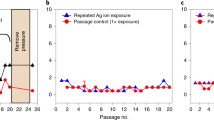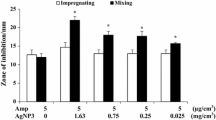Abstract
Silver resistance was studied in a silver-resistant Pseudomonas stutzeri AG259 strain and compared to a silver-sensitive P. stutzeri JM303 strain. Silver resistance was not due to silver complexation to intracellular polyphosphate or the presence of low molecular weight metal-binding protein(s). Both the silver-resistant and silver-sensitive P. stutzeri strains produced H2S, with the silver-resistant AG259 strain producing lower amounts of H2S than the silver-sensitive JM303 strain. However, intracellular acid-labile sulfide levels were generally higher in the silver-resistant P. stutzeri AG259 strain. Silver resistance may be due to formation of silver-sulfide complexes in the silver-resistant P. stutzeri AG259 strain.
Similar content being viewed by others
References
Aiking H, Kok K, Van Heerikhuizen H, Van T Riet J. 1982 Adaptation to cadmium by Klebsiella aerogenes growing in continuous culture proceeds mainly via formation of cadmium sulfide. Appl Environ Microbiol 44, 938–944.
Belliveau BH, Starodub ME, Trevors JT. 1991 Occurrence of antibiotic and metal resistance and plasmids in Bacillus strains isolated from marine sediment. Can J Microbiol 37, 513–520.
Brierley CL, Kelly DP, Seal KJ, Best DJ. 1985 Materials and biotechnology. In: Higgins J, Best DJ, Jones J. eds. Biotechnology. Principles and Applications. Boston, MA: Blackwell Scientific Publications; 163–212.
Bragg PD, Rainnie DJ. 1974 The effect of silver ions on the respiratory chain of Escherichia coli. Can J Microbiol 20, 883–889.
Clark MW, Yip MR, Campbell J, Abelson J. 1990 SSB-1 of the yeast Saccharomyces cerevisiae is a nucleolar-specific silver-binding protein that is associated with the snR10 and snR11 small nuclear RNAs. J Cell Biol 111, 1741–1751.
den Hollander JA, Ugurbil K, Brown TR, Shulman RG. 1981 Phosphorus-31 nuclear magnetic resonance studies of the effect of oxygen upon glycolysis in yeast. Biochemistry 20, 5871–5880.
Gadd GM, Laurence OS, Briscoe PA, Trevors JT. 1989 Silver accumulation by Pseudomonas stutzeri AG259. Biol Met 2, 168–173.
Ghandour W, Hubbard JA, Diestrung J, Hughes MN, Poole PK. 1988 The uptake of silver ions by Escherichia coli K12: toxic effects and interaction with copper ions. Appl Microbiol Biotechnol 28, 559–565.
Goddard PA, Bull AT. 1989 Accumulation of silver by growing and non-growing populations of Citrobacter intermedius B6. Appl Microbiol Biotechnol 31, 314–319.
Grier N. 1977 Silver and its compounds. In: Block SS, ed. Disinfection, Sterilization, and Preservation. Philadelphia: Lea and Febiger.
Haefeli C, Franklin C, Hardy K. 1984 Plasmid-determined silver resistance in Pseudomonas stutzeri isolated from a silver mine. J Bacteriol 158, 389–392.
Higham DP, Sadler PJ, Scawen MD. 1984 Cadmium-resistant Pseudomonas putida synthesizes novel cadmium proteins. Science 225, 1043–1046.
Holt JG, ed. 1984. Bergey's Manual of Systematic Bacteriology, Vols 1 and 2. Baltimore, MD: Williams and Wilkins.
Hughes MN, Poole RK. 1989 Metals and Microorganisms. London: Chapman and Hall; 287–291.
King TE, Morris RO. 1967 Determination of acid-labile sulfide and sulfhydryl groups. Methods Enzymol 10, 634–641.
Lohmeier-Vogel EM, Hahn-Hägerdal B, Vogel HJ. 1986 Phosphorus-31 NMR studies of maltose and glucose metabolism in Streptococcus lactis. Appl Microbiol Biotechnol 25, 43–51.
Lohmeier-Vogel E, Skoog K, Vogel H, Hahn-Hagerdal B. 1989 31P nuclear magnetic resonance study of the effect of azide on xylose fermentation by Candida tropicalis. Appl Environ Microbiol 55, 1974–1980.
Lundberg P, Harmsen E, Ho C, Vogel HJ. 1990 Nuclear magnetic resonance studies on cellular metabolism. Anal Biochem 191, 193–222.
MacFaddin JF. 1976 Biochemical Tests for Identification of Medical Bacteria. Baltimore, MD: Williams and Wilkins; 89–99.
McNeilage LJ, Whittingham S. 1984 Use of Bio-Rad silver stain to identify gel purified RNA components of small nuclear ribonucleoprotein antigens. J Immunol Methods 66, 253–260.
Merril CR, Goldman D, Vankeuren ML. 1984 Gel protein stains: silver stain. Methods Enzymol 104, 441–447.
Modak SM, Fox Jr CL. 1973. Binding of silver sulfadiazine to the cellular components of Pseudomonas aeruginosa. Biochem Pharmacol 22, 2391–2404.
Nakahara H, Yonekura I, Sato A, et al. 1989 Plasmid-determined resistance to silver in Enterobacter cloacae isolated from sewage. Water Sci Technol 21, 275–278.
Navon G, Shulman RG, Yamane T, et al. 1979 Phosphorus-31 nuclear magnetic resonance studies of wild-type and glycolytic mutants of Saccharomyces cerevisiae. Biochemistry 18, 4487–4499.
Nicolay K, Scheffers WA, Bruinenberg PM, Kaptein R. 1982 Phosphorus-31 nuclear magnetic resonance studies of intracellular pH, phosphate compartmentation and phosphate transport in yeasts. Arch Microbiol 133, 83–89.
Pan-Hou HSK, Imura N. 1991 Role of hydrogen sulfide in mercury resistance determined by plasmid of Clostridium cochlearium T-2. Arch Microbiol 129, 49–52.
Phillips R, George P. 1968 Metal-ATP bindings. I. Thermodynamic data for adenosine-silver binding. Biochim Biophys Acta 162, 73–78.
Pooley FD. 1982 Bacteria accumulate silver during leaching of sulphide ore minerals. Nature 296, 642–643.
Savvaidis I, Nobar A, Hughes MN, Poole RK. 1990 Displacement of surface-bound cationic dyes: a method for the rapid and semi-quantitative assay of metal binding to microbial surfaces. J Microbiol Methods 11, 95–106.
Silver S, Misra TK. 1988 Plasmid-mediated heavy metal resistances. Annu Rev Microbiol 42, 717–743.
Slawson RM, Lee H, Trevors JT. 1990 Bacterial interactions with silver. Biol Met 3, 151–154.
Slawson RM, Trevors JT, Lee H. 1992 Silver accumulation and resistance in Pseudomonas stutzeri. Arch Microbiol 158, 398–404.
Starodub ME, Trevors JT. 1989 Silver-resistance in Escherichia coli R1. J Med Microbiol 29, 101–110.
Starodub ME, Trevors JT. 1990 Silver accumulation and resistance in Escherichia coli R1. J Inorg Biochem 39, 317–325.
Thomas DG, Linton HJ, Garvey JS. 1986 Fluorometric ELISA for the detection and quantitation of metallothionein. J Immunol Methods 89, 239–247.
Traxler RW, Wood EM. 1990 Bioaccumulation of metals by Coryneform SL-1. J Ind Microbiol 6, 249–252.
Vernier PT. 1992 ‘Elements’ Version 1.0. Software package. From: Handbook of Chemistry and Physics. 72nd ed. 1991–1992 Boca Raton, FL: CRC Press.
Yahya MT, Landeen LK, Messina MC, Kutz SM, Schultz R, Gerba CP. 1990 Disinfection of bacteria in water systems by using electrolytically generated copper: silver and reduced levels of free chlorine. Can J Microbiol 36, 109–116.
Author information
Authors and Affiliations
Rights and permissions
About this article
Cite this article
Slawson, R.M., Lohmeier-Vogel, E.M., Lee, H. et al. Silver resistance in Pseudomonas stutzeri . Biometals 7, 30–40 (1994). https://doi.org/10.1007/BF00205191
Received:
Accepted:
Issue Date:
DOI: https://doi.org/10.1007/BF00205191




